

The coolest car you’ll read about today is a Nissan Leaf. Yeah, really. Sure, it’s a mighty fine car for tooling around town, but it’s pretty tough to make the Leaf sound or look cool. That is unless you’re a mechanical engineer who had the idea to stuff a Kawasaki motorcycle engine into the trunk of a Leaf and actually went through with it. The result is a Nissan Leaf hybrid with an engine that screams to 13,000 rpm.
Why build a Kawasaki-powered Leaf? Derek Young of San Francisco says it’s actually quite simple: he wanted a motorcycle-powered car for the revs and the raw nature of it, and he chose the Leaf because it was cheap and relatively simple.

Being a front-wheel drive EV, the Nissan Leaf has very few mechanical components at the rear axle. Plus, he found one with a heavily degraded battery that wasn’t worth much. So stuffing the Kawasaki ZX-10R engine into the trunk was the easiest and cheapest path to building Young’s motorcycle-powered car. Of course, it wasn’t as simple as just throwing the engine in there, as some heavy modifications were needed. Thankfully, being an engineer, Young was up to the task.
To mount the 998cc four-cylinder engine, Young modified a Lexus IS350 rear subframe to fit in the rear of the Leaf. Once the subframe was fitted, Young was able to mount the engine to it via custom brackets. Getting the engine to drive the rear axles was a bit trickier, though. Young had to connect the sequential transmission’s chain drive to an idler sprocket, which then turned the differential. The diff came from Quaife and is meant specifically for putting motorcycle engines in cars.
With the engine in the trunk, Young separated it from the rest of the cabin with an acrylic wall and fed it air from a side window-mounted air intake. For air to exit the radiator, Young built a gurney flat at the back of the rear tailgate, creating a low-pressure area in which an exit flap could open.

You might think that after swapping the Kawasaki engine Young scrapped the Leaf’s stock powertrain, but the opposite is true. Not only did he keep the stock electric motor and battery, he turned it into a fully functioning, all-wheel drive plug-in hybrid. A dial on the dashboard adjusts the level of hybrid intervention he wants, so the Young can choose from a 1:1 hybrid setting (both the electric motor and engine equally), pure EV mode, and an engine-biased max power mode.
Despite its pure EV mode, Young’s screaming hybrid can’t drive very far. Before the project even started, the Leaf’s battery had degraded enough to drop its maximum range to around 25 miles. However, that’s enough that the Kawasaki-powered hybrid can be driven quitely in EV mode around town, before opening the taps of its engine on more exciting roads.
Its brakes are made from a mashup of different car parts. For example, its front calipers are from a Nissan 370Z but the front rotors are from a Mustang, while the rear brakes are carryover from the Lexus IS350 rear subframe. It rides on Enkei wheels wrapped in Nexen tires.
Young uses his hybrid Leaf primarily as a track car and it looks like a blast. The engine screams to its 13,000 rpm redline and makes an incredible noise. It must be epic from inside the car, considering a piece of acrylic separates the driver’s ears from the engine compartment. Young reckons more car companies should build exciting, inexpensive hybrids with high-revving engines. While that’s a certainly unrealistic, we look forward to seeing more passion projects like this one, keeping internal combustion engines alive long after electrification has fully taken over.

Got tips? Send ’em to tips@thedrive.com